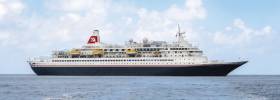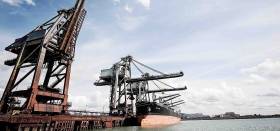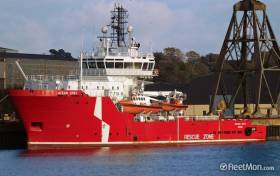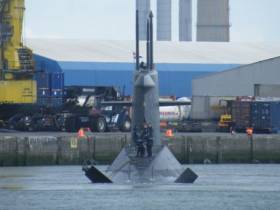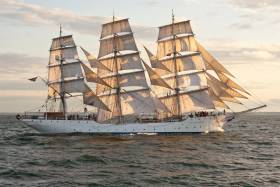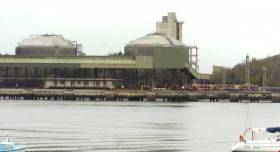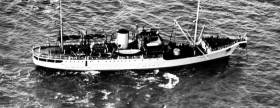Displaying items by tag: Cork Harbour News
Quartet of Cruiseships Coming to Cork for Christmas
#CobhChristmasCall - A quartet of cruiseships will come to Cork Harbour this festive season, including one on Christmas Day, bringing 5,000 visitors to the region.
The increase writes the Evening Echo in winter cruiseships highlights a changing industry. Cork traditionally welcomes cruiseships into Cobh from April to October, and 58 vessels arrived this year.
The larger ocean liners are then redeployed to the Caribbean, the Meditteranean, or to the southern ocean around Australia. However, increased competition means vessels operated by UK and German cruise companies are continuing in northern Europe throughout the winter.
Earlier this week, the Bodicea called to Cobh and will be followed by the Balmoral, on Saturday, and the Marco Polo, on Monday. Then, on Christmas Day, Black Watch, operated by Fred Olsen Cruise Lines, will come to Cobh. The four vessels have a capacity of 5,600 passengers and crew.
For more from Captain Michael McCarthy, the commercial manager of the Port of Cork, click here.
Tata Commits to Saving Steel Port Talbot’s Future
#SteelPort - Upgrading infrastructure work at ABP’s port of Newport, south Wales involved an engineering firm from Port Talbot where also located is the giant steelworks of Tata Steel whose 4,000 strong workforce recieved much welcomed news yesterday, writes Jehan Ashmore.
The Welsh workforce were given a commitment to job security and across Tata’s other UK plants according to BBC News. It could bring an end to eight months of uncertainty for thousands of workers who faced losing their jobs when Tata's UK business was put up for sale. Tata held talks with unions yesterday (Wednesday) and said it was "an important step forward" for its future in the UK. But workers still have to agree to pensions changes and will be balloted.
Almost 7,000 people are employed by Tata Steel across Wales, including those in Port Talbot, to read more click here. The port located between Swansea and Barry (see former Seaspeed Ferries) along with Cardiff and Newport make up ABP South Wales five ports handling more than 13 million tonnes of cargo annually. In total Associated British Ports group has 21 ports throughout the UK.
It is at this Bristol Channel port one of only a few harbours in the UK that Port Talbot is capable of handling cape-size vessels of up to 170,000dwt. The two 300m long berth of the deepwater jetty built in the 1970’s is predominantly for importing coking coal, minerals and ores to the Tata plant which is Indian owned.
On the other side of the Celtic Sea, the last such steel works in the Republic was the Irish Steel plant in Cork Harbour. The factory on Haulbowline Island was on a site of a former 1869 dockyard neighbouring the Naval Service Base. The plant’s last owners ISPAT /Irish Steel, also an Indian owned business had a workforce of 400 until closing in 2001 with accumulated losses of £10m.
A legacy of such heavy industry remains as Afloat reported in January of the then Marine Minister Simon Coveney announcment of a two-and-a-half-year programme of core remediation works during a meeting with the Haulbowline Remediation Project Stakeholders Group.
Remediation of the contaminated waste site is to be completed by mid-2018. This followed a Government decision to provide a total of €61 million to remediate the location on a “whole of Island basis”, incorporating both the east and south tips and including a ground level remediation of the former factory site.
The eyesore of the spoil site on the eastern end of Haulbowline Island over the years could easily be seen by tourists on board inbound Brittany Ferries Roscoff-Cork seasonal-only sailings.
Flagship Pont-Aven whose environmental credentials consist of funnel sulphur emission ‘scrubber’ technology which was installed before this season. The 'green' measures were taken so to comply with an EU Directive on Sulphur Emissions.
The Ireland-France seasonal connection has been extended over the years with sailings running up to early November. Sailings on the continental service are to resume in April 2017.
Mainport Group Acquire Supply Support Vessel for Kinsale Gas Field
#MainportKinsale - Afloat first reported of Ocean Spey operating at the Kinsale Gas Field last Wednesday and now it can be confirmed the standby supply support vessel is to be reflagged under the Irish tricolour having been acquired by Mainport Group, writes Jehan Ashmore.
The 1,864 tonnes Ocean Spey had been based at Aberdeen (see photo) the 'oil' capital of Scotland until she sailed six weeks ago to Cork Harbour, homeport of the Mainport Group.
The 66m long Ocean Spey has yet to be given a customary company ‘tree’ suffix themed name i.e. Mainport Cedar (harking back to the Irish Shipping Ltd fleet era). The vessel is currently offshore of the pair of gas rig platforms, Kinsale Alpha and Bravo some 50kms offshore of the Cork coastline.
Ocean Spey is a Norwegian 2000 year built vessel with anchor handling capacity that replaced Mainport’s standby supply ship, Pearl. This 1,579 grt vessel has served the Kinsale Gasfield since 1985.
Mainport provides the newcomer, Ocean Spey to serve at the PSE Kinsale GasField offshore gas installation which has changed hands since gas extraction began in the late 1970’s. A Mainport subsidiary, Seahorse having then begun operations with albeit smaller vessels the Seahorse Minder and Seahorse Supplier.
Some three weeks ago, Pearl was stood down and destored at her usual berth at Ringaskiddy. The 65m vessel then relocated the short distance across Cork Harbour to where the vessel remains alongside Cork Dockyard. There was an interim period when Mainport deployed Celtic Isle of subsidiary Celtic Tugs at the gasfield prior to the introduction of Ocean Spey.
Also recently in Cork Harbour, Mainport Cedar, as previously reported on Afloat back in 2014, was the first of a pair of newbuild Malaysian built seismic-survey vessels delivered to Mainport of the previous year. Notably earlier this year the vessel was detained during a charter for a UN World Food Programme mission to war-torn Yemen.
This was Mainport Cedar's first ever call to Cork Harbour and this was due to maintenance requirements in between sailing from the North Sea and the Gulf of Mexico. The work carried out took place at Cork Dockyard in advance of a contract to a seismic company for the oil sector in the Gulf of Mexico as also featured in last Friday’s Seacapes.
The seismic-survey vessel has since departed Cork Harbour on the North Altantic repositioning voyage.
Dutch 'Walrus' Class Submarine Driven Away by Russian Navy in Eastern Mediterranean
#Submarines – A Dutch Navy submarine which Afloat.ie covered in departing Cork Harbour on Monday is a ‘Walrus’ class submarine, one in which was driven away two days later by Russian warships in the eastern Mediterranean Sea.
A Russian defence ministry spokesman Maj Gen Igor Konashenkov said two Russian navy destroyers spotted the Walrus-class submarine on Wednesday while it was 11 nautical miles away from the Admiral Kuznetsov aircraft carrier and its escorting ships, reports the Associated Press.
The destroyers had tracked the submarine for more than an hour, using anti-submarine helicopters, before forcing it to leave the area, he said. The spokesman added that such “clumsy” attempts to manoeuvre close to the Russian squadron could have resulted in an accident. For more on this story published in The Irish Times, click here.
As previously reported at the ‘Our Maritime Heritage Conference’ held in Belfast last month, Afloat.ie first learnt the Royal Navy’s HMS Duncan was forced to abandon a scheduled visit to the city. Instead the Type 45 destroyer, part of a NATO quartet diverted to the English Channel to ‘shadow’ an eight-strong Russian Navy flotilla notably led by flagship aircraft carrier Admiral Kuznetsov bound for Syria.
The giant 58,000 tonne and powerful Admiral Kuznetsov, the Russian Federation’s sole aircraft carrier was accompanied by nuclear-powered Peter the Great, a missile cruiser.
It was only last weekend that HMS Duncan, one of the Royal Navy’s most modern and powerful destroyers which is affiliated with Belfast finally called to the city along with frigates from Germany, Spain and Portugal. The call followed reports that Russian submarines in the Irish Sea in recent weeks were tracked by the Royal Navy.
As previously highlighted by Afloat’s WM Nixon, the naval presence of Admiral Kuznetsov which drew much attention as the aircraft carrier belched black smoke while passing the famous White Cliffs of Dover. The aging carrier constructed between 1982 and 1992 has always been regarded as a bit of a jinxed ship with such a history of engine breakdown that she never goes anywhere without her own personal tugboat in attendance, just to be sure to be sure.
According to Ships Monthly's September issue, it would seem Admiral Kuznetsov will finally receive more detailed attention to her troublesome engines as the giant aircraft carrier is scheduled to have a major refit in 2017. The ageing aircraft carrier has not been extensively modernised since entering service more than a quarter century ago.
Next year’s refit is primarily to focus on upgrading the flight deck equipment so to improve the launch and recovery rate of aircraft. The aircraft currently deployed in the naval deployment mission to Syria involve a combination of composite air wing fighter craft as well as helicopters.
Dutch Navy's 'X' Stern Submarine to Visit Cork City
#X-Submarine - A Dutch navy non-nuclear powered submarine built during the Cold War is this afternoon arriving to Cork City for a four-day visit, writes Jehan Ashmore.
HNLMS Bruinvis is a diesel electric powered submarine. The 68m submarine is equipped with almost 40 torpedoes and is the final ‘Walrus’ class of four built. Leadship HNLMS Walrus visited Dublin Port earlier this year.
On this occasion, the visit of the Royal Netherlands Navy (NATO member) submarine takes place at Cork city centre’s JJ Horgan's Wharf on the north quays. The crew are to spend their on leave time in the southern city for the purposes of rest and recreation.
What makes these class unusual to other submarines is the "X" tail configuration design. This involves in mounting four combined rudders and diving planes to form the an "X" tail at the stern (see above photo).This differs to the conventional cross-shaped assembly of stern diving planes and rudders.
The contract for the submarine was given to Rotterdamsche Droogdok Maatschappij (Rotterdam Dry Dock Co). Construction began in 1988, one year before the fall of the Berlin Wall and the end of the Cold War in 1991. Three years later HNLMS Brunis was commissioned into service.
US Naval Destroyer Surrounded By Ring of Steel Visits Cobh
#USdestroyer - A high-security cordon will be put in place around a US Naval Destroyer during a three-day visit to Cobh, Cork Harbour.
In yesterday's Evening Echo it was reported that USS Porter was due to dock at the Cobh Deepwater Cruise Berth at 9am for the courtesy visit. Afloat.ie can confirm the Arleigh Burke class destroyer arrived this morning.
However, a strict exclusion zone will be in place around the Destroyer with other vessels banned from coming within 50 metres of her.
The cordon will be monitored by the Irish Navy and the gardaí.
The Port of Cork’s Harbour Master Paul O’Regan issued a notice to all mariners in Cork Harbour warning them of the exclusion zone.
For more on the visit of the destroyer (click here) that entered the Black Sea in June as part of NATO’s ongoing efforts in response to Russia’s actions in Ukraine.
Norwegian Tallship to Remain On Cork Visit As Trainees Study In Port
#Tallships - The Norwegian tallship, Christian Radich, one year short of its 80th anniversary sailed upriver from a Cork Harbour anchorage to berth in the city this morning, writes Jehan Ashmore.
The fully-rigged ship it transpires did not depart into the open seas today as previously reported. Instead the 1937 built ship berthed at the North Custom House Quay.
The visit to the city-centre is private and will run beyond the weekend to at least mid-week. This it to facilitate trainees who are to attend a maritime course.
Christian Radich is one of two of Norway’s most famous large tallships, the other ship been Statsraad Lehmkuhl dating to 1914.
The square-rigger in August made a visit to Dublin as part of National Heritage Week.
Fully Rigged Norwegian Tallship Anchors in Cork Harbour
#Tallship - A Norwegian tallship classified as a fully rigged ship which is to celebrate its 80th anniversary next year is at anchorage in Cork Harbour today, writes Jehan Ashmore.
Christian Radich will be marking the 80th anniversary by making special commemorative voyages along the spectacular Norwegian coast.
In the meantime her visit to Cork Harbour follows sailing in UK waters and having set off almost a fortnight ago from her homeport of Oslo. She is anchored in the lower Cork Harbour between Cobh and Whitegate and is to remain until a departure tomorrow morning.
Another Norwegian tallship which is even older having been built more than a century ago in 1914 is Statsraad Lehmkuhl, which made a visit to Dublin as part of National Heritage Week in August.
The pair serve as ambassadors of the Nordic state, which has a very strong maritime tradition, notably in the energy and exploration sectors.
Operated by an Oslo based foundation, the 1937 built Christian Radich, has been preserved for future generations as primarily serving as a school ship. Setting a sail area of 1360,00 m2, the trainee ship is used for voyages for 15 trainees of all ages and is available for charter.
The services of the tallship were also used by the Norwegian Navy’s officer school, however they were unable to renew the contract with Christian Radich after April 2015, despite it been a successful collaboration.
Other clients in the form of Norwegian maritime college students have taken up sail training from September to May. It is during this current winter programme that Christian Radich is offering a week's voyage around the Canary Islands beginning next year in early January.
Looking further ahead in April, there are places for those who want to compete in a race as the Christain Radich enters the first leg in the rendez-vous of the 2017 Tall Ships Regatta. This is to take place in Greenwich, downriver of central London before heading to Canada.
€18m Redevelopment Plan in Cork Harbour Faces Delay
#SiteDelay - An €18 million plan in Cork Harbour to redevelop a key industrial site writes The Irish Times, faces a delay after the joint venture backing it withdrew its notification to the State’s mergers watchdog.
Port of Cork is leading a consortium that intends to buy the 114-acre Irish Fertiliser Industries’ (IFI) facility at Marino Point, close to Cobh, from the National Asset Management Agency (Nama) to redevelop as a facility to handle oil and farming products.
The port company and its partners, which include publicly quoted Origin Enterprises, withdrew their notification of the deal to the Competition and Consumer Protection Commission (CCPC) yesterday.
The move is likely to delay plans to redevelop the site, as deals on the scale they propose must get the commission’s approval before going ahead. Any plan for the IFI site will have to be notified to the commission again before proceeding.
For more on the story and that of the CCPC click here
Exhibition: Safety at Sea through War and Upheaval: Irish Lights 1911-1923
#Exhibition - The Commissioners of Irish Lights have joined the Royal Irish Academy to bring an exhibition that captures the history of Irish Lights, the history of the island of Ireland itself, its ever-changing coasts and shorelines, and the history of the people who lived along our island’s seaboard.
What emerges is a never-before told story of devotion to duty, scientific, engineering and physical endeavour, world war, revolution and change. It is also a deeply personal story of those who worked with and built up Irish Lights and who devoted their lives to protecting the coastline for the safety of all.
Through the nineteenth century the number of Ireland’s lighthouses increased from fourteen to seventy-four, with eleven lightships placed around the east and south coasts.
The exhibition explores how Irish Lights, with its origins in the late-eighteenth century, and coming of age in the certainties of the nineteenth, faced the challenges of global and national uncertainty in the early twentieth century. Precisely, the exhibition details Irish Lights’ history between 1911 and 1923.
This exhibition explores these years, and incredible events, such as; the Easter Rising of 1916, the Anglo-Irish War of 1919–1921, and the Anglo-Irish Treaty.
The exhibition will be showcasing in venues all along the Irish coastline in 2016.
Currently the exhibition is been held at Cobh Library on Casement Square until Saturday 15th October
Opening Times:Tuesday to Saturday - 9.30am - 5.30pm
Closed on Mondays and Saturdays




























